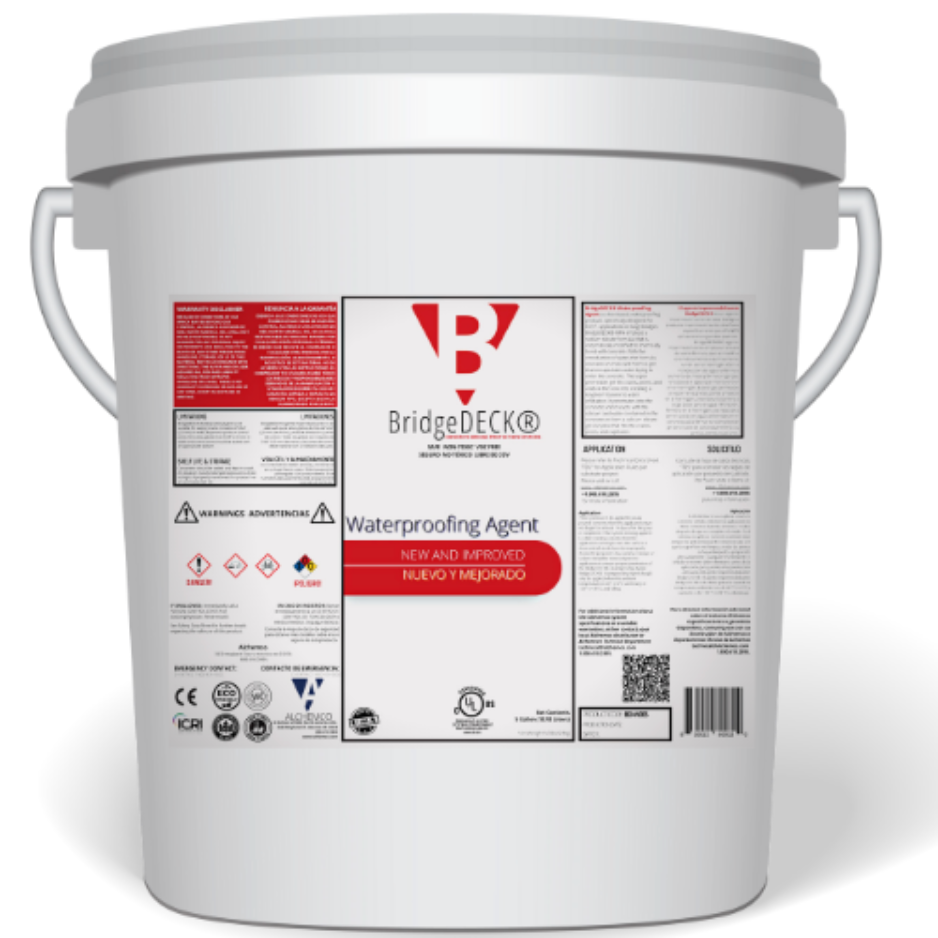John Oglesby, The Parking Whisperer
“You are the best kept secret, virtually no downtime, Alchemco has the good, better, and best options.”
Jeffrey Pouliotte, PE
“With freeze/thaw where the water continues to hydrate the concrete, the gel will actually move and won’t cause the concrete to crack”
2023 Industry and Expert Choice Winner, World of Concrete
Meet our Award Winning Formula
Products for Highway and Bridge Protection
Waterproofing Agent
25-Year Performance
2-time award winner of the
2023 Most Innovative Product Awards
PROtectant Plus
20-Year Performance
CorrosionBLOK
5-Year Performance
PROtectant
15-Year Performance
-
Preventative Maintenance, as a way to substantially extend the service life of highway bridges continues to be a growing trend in the U.S. and around the world. A wide range of studies over the years have reached a similar conclusion; that budgeting for & performing preventative maintenance on concrete bridge decks significantly extends their service life. The extremely high cost of replacing damaged & decaying bridges (in terms of both money and disruption), has the entities responsible for managing these bridges focusing more & more on economical, long-term ways to extend the service life of these important assets.
Unfortunately, over the years there has not been much agreement on how to best approach this critical infrastructure issue. The growing annual use of deicers on highways & bridges (salt, brines, magnesium chloride, etc.) and their destructive effects on unprotected concrete just highlights the need for increased protection of bridge decks across the country. In addition, to the corrosive effect those chemicals have on the steel reinforcement embedded in the concrete decks, there are other factors accelerating the decay of the concrete as well, such as alkali-silica reaction (ASR), freeze-thaw conditions (in the cold-weather states), and carbonation.
-
From a concrete waterproofing & protection standpoint, the highway bridge market in the United States is a complex and complicated industry segment. The design, maintenance & repair of highway bridges in the U.S. has evolved over time into a very diverse and fractured place for manufacturing companies to operate in. Each state’s Department of Transportation (D.O.T.) has developed and follows its own guidance and regulations regarding the design/construction of new bridges, as well as the maintenance & repair of existing bridges located on the state & interstate highways, they’re responsible for.
Each state also has lower tier of government entities (counties, cities, villages, etc.) that are tasked with managing & budgeting for the design/construction of new bridges, as well as the ongoing maintenance/repairs of the bridges located on the roads & highways that they are responsible. In many states, those lower tier entities rely heavily on the guidance of that state’s Department of Transportation regarding how they manage the construction & maintenance of their bridges. However, that is not always the case. Lastly, there are also tollways with bridges in many of the states that are owned & operated by a separate entity all together.
-
Adding to the complexity of the situation is the wide variety of product offerings & technology types that have been developed and used over the years. Depending on the state they’re located in, and the timeframe they were built during, the majority of highway bridges in the U.S. were designed to perform for a service life 50 to 75 years (some newer bridges are designed for 100-year service lives). As you can imagine, with the wide variety of decision-makers located in the state, county & local highway department offices, each faced with a smorgasbord of product & technology options to choose from, there is very little consensus on those decisions. In fact, there isn’t even a consensus in some states on whether to budget funds for the preventative waterproofing of highway bridges, or if they should just fix them once they eventually need repairs.
Lastly, to provide a little scope & scale to this situation, there is very little similarity between the State of Delaware for instance which has less than 1,000 highway bridges to manage, and the State of Texas which has over 50,000 bridges to deal with.
-
The most commonly used type of overlay system in the U.S. They are two-component systems that are known for having high bond-strength and low initial shrinkage. They generally consist of an epoxy resin and a curing or hardening agent. Many of these systems do not require a primer to be used once the concrete deck has been cleaned & prepped, and they are generally applied using a multiple-layer method (also referred to as a broom-and-seed method). Normally two or three layers of epoxy are applied, with an aggregate broadcast into each layer that has been approved by the product manufacturer. After each layer has cured, any unbound aggregate is removed, and the next layer of product and aggregate is applied.
-
Two-component systems, generally consisting of a polyester- styrene resin and an organic peroxide that’s used as a promoter or initiator to affect the curing rate.
Polyester overlays are typically installed using the premix method and are screeded to grade. Fine aggregate is broadcast on the surface for initial skid resistance. These systems generally require a primer to be used on the bridge deck prior to application of the overlay products.
-
Two-component systems that generally consist of a methyl methacrylate resin and a small dose of organic peroxide that is used as an initiator.
Methacrylate overlays are often applied using the slurry method and are combined with aggregates to complete the overlay system. In order to use these systems, the bridge deck and the aggregate must be completely dry, due to methacrylate’s extreme sensitivity to moisture. Methacrylate top-coats are also available to help bond/encapsulate the aggregate into the system.
The most common chemistries used to create products in this category are Poly Methyl Methacrylate (PMMA) & Polyurethane Methacrylate (PUMA).
-
While the Penetrating Deck Sealer category has consisted of products using several different chemistries
over the years, the two options used most often are Silanes and Siloxanes. These concrete sealers are spray-applied liquids designed to cover the entire bridge deck (not just the cracks). They penetrate the surface of the concrete and act as a ‘water repellant’ (hydrophobic).
NOTE: they do not qualify to be in the ‘waterproofing’ category, and do not have the ability to seal existing or future cracks.
-
Silane sealers may not be the ideal choice for those looking to enhance and protect their concrete surfaces. Silane sealers, which work by penetrating the concrete, can be somewhat disappointing due to their limited effectiveness in certain scenarios. While they do create a hydrophobic barrier, their ability to protect against the elements, especially in harsh weather conditions, falls short of expectations. This can lead to issues such as water penetration, freeze-thaw damage, and the formation of unsightly stains on the concrete.
While concrete silane deck sealers provide some level of protection, they may not meet the expectations of those looking for comprehensive and visually pleasing solutions for their concrete surfaces.
-
Siloxanes are often touted for their water-repellent properties, but in practice, their effectiveness can be rather underwhelming. They tend to provide only limited protection against water intrusion, and this can be a significant drawback in areas with heavy rain or frequent exposure to moisture. Concrete decks sealed with siloxane sealers are often prone to water damage, which can result in cracks, pitting, and a compromised structural integrity.
Another downside of concrete siloxane deck sealers is their short-lived performance. These sealers typically require frequent reapplication, and their durability leaves much to be desired. Over time, the protective barrier diminishes, and the concrete deck becomes vulnerable to various forms of deterioration. Siloxanes may leave structures prone to deterioration due to their limited protection and frequent reapplication requirements.
-
Enzymatically modified silicate gel works within concrete structures to provide long-lasting waterproofing and prevent deterioration over decades by employing a unique chemical bonding and self-healing mechanism. When applied to the concrete surface, the gel penetrates the substrate and forms a chemical bond with the minerals in the concrete. This bond is highly durable and resistant to the effects of moisture, ensuring that the gel does not weaken or deteriorate over time. As a result, it creates an enduring, impermeable barrier that prevents water intrusion into the concrete. Unlike some traditional waterproofing methods that may degrade over the years, this chemical bond remains stable, providing consistent protection against moisture and the associated risks of corrosion and structural damage.
Enzymatically modified silicate gel offers a self-healing property. When the concrete experiences minor cracks or voids due to thermal expansion, settlement, or other stress factors, the gel reacts with any incoming water and forms a gel barrier within these cracks. This self-healing process seals off potential entry points for water, preventing further damage and deterioration. This dynamic response ensures that the concrete remains protected and structurally sound, not just for years but for decades. The combination of chemical bonding and self-repairing capabilities sets enzymatically modified silicate gel apart as a long-lasting and effective solution for preserving the integrity of concrete structures.























